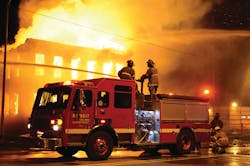As Firehouse Sees It: Did You Know That?
The first installment of what has grown to be the multi-part annual National Run Survey appears on page 50. The numbers for the busiest engine category fluctuate, but remain extremely high for some cities – to more than 9,000 runs. This is mostly due to an increase in responses to EMS calls and emergencies. No surprise there.
I read that every smoke detector activates a couple of times during its life span. I know the smoke detectors in my response area are always very active. I once accused the maintenance staff of a large facility in my town of just switching their defective smoke detectors – when there was a problem with one smoke detector, they took it down and placed it on a shelf in a storage closet, and when another detector activated, I said they took the one on the shelf and put it back up to replace the current bad detector. It certainly seemed like it. Many departments have changed their policies for responding to certain types of alarms. Driving without lights and sirens to get units to the scene slower and safer is making a difference.
Over the past few weeks, I’ve had the opportunity to do a lot of traveling and meeting with fire chiefs across the country. A number of departments are struggling with reduced manpower, brownouts, and salary and pension concessions because of the economy. There are, however, just as many, if not more, that are moving forward. Just like the good and the bad, many departments are locked into knockdown battles between labor and management while others are working together to bring a positive solution to their common problems.
One item on the EMS front: survival rates are way up with new American Heart Association guidelines. I found it to be true in Glendale, AZ, and Las Vegas, NV, as well as many other departments. Through the use of new procedures involving refrigerators on units with chilled IVs and machines that perform continuous automatic compressions, survival rates are much higher than average.
Recently, I was invited to attend the premiere of the documentary “Burn,” billed as “One Year on the Front Lines of the Battle to Save Detroit.” This took place as part of the Tribeca Film Festival in New York City. The festival was started by actor Robert De Niro to restart the economy of lower Manhattan after 9/11. After Detroit Firefighter Walter Harris died in the collapse of the attic of a vacant building, the film makers wondered why someone would risk his life for a vacant building. They wound up at Engine 50’s firehouse; in the first two days, they went to 21 fires. Over the next year, they captured emotions, dangers and firehouse life. On Aug. 13, 2010, one of the firefighters in the film was critically injured in a collapse.
I sat down and talked with some of the firefighters in the film: Chief Craig Dougherty, Field Engine Operator Dave Parnell (retired), Senior Firefighter Dave Miller, Firefighter Brendan “Dougie” Milewski (retired) and the films directors, Tom Putnam and Brenna Sanchez. The film is being well received and captures the behind-the-scenes action in a city that continues to burn day after day. One of the most amazing scenes depicted the last night tour before Dave Parnell retired. All the units from the battalion share in his last night. One by one, they all catch a run. Lastly, there is no one else at the firehouse except Engine 50, his company. Of course, out the door they go to another run.
Sadly, Detroit firefighters hadn’t had a raise since 1999. If you think things are bad where you are, consider this: the city just announced it is giving every Detroit firefighter a 10% pay cut.
For comments and suggestions, please contact us at [email protected].
